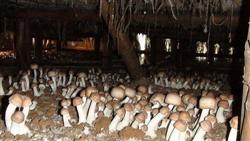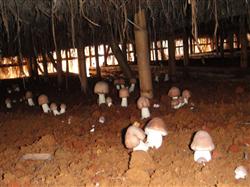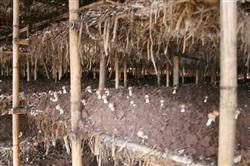Planting techniques of Agaricus blazei Murrill: how to grow Agaricus blazei Murrill in the north?

How to grow Agaricus blazei Murrill in the north? Please introduce the method due to climate constraints in the north, Agaricus blazei Murrill cultivation has been restricted. In view of the problems existing in the cultivation of Agaricus blazei Murrill at home and abroad and the characteristics of resources and climate in Northeast China, the biological characteristics, cultivation conditions and management techniques of Agaricus blazei Murrill were systematically studied from the Institute of Edible Fungi of Fujian Academy of Agricultural Sciences. Adaptive domestication cultivation and mushroom emergence experiments were carried out with preliminary success. 1 the biological characteristics of Agaricus blazei Murrill are medium-temperature and high-temperature fungi. The mycelial growth was 10 ℃ 37 ℃, and the optimum temperature was 25 mol 27 mol. The optimum pH6.5-7.5 is 1.0 ℃ of material to water, the most suitable carbon source is sucrose, its concentration is 7%, and ammonium sulfate is the most suitable nitrogen source, its concentration is 0.3%. The development temperature of fruiting body is 20ml 26 mol. Light is not needed in the mycelium growth stage, and a small amount of scattered light is needed in the fruiting body growth stage. (2) according to the biological characteristics of Agaricus blazei Murrill, the cultivation seasons should be arranged in spring, summer and autumn according to the natural climatic conditions in the north, which can be carried out according to Table 1. Table 1 Agaricus blazei Murrill in spring, summer, Cultivation arrangement of autumn three seasons (month / day) Spring mushroom cultivation, summer mushroom cultivation, summer mushroom cultivation, autumn mushroom cultivation mother seed rejuvenation 12 2 (year) 6 original seed production January (year) 3 7 raw material reserve 2 / mid and late ten days 4 / middle and late ten days 7 / middle and late ten days cultivation seed production 248 cultivation materials stack 3 (in greenhouse) 58 cultivation site selection 3 / late ten days (temperature room) 5 / middle ten days (indoor) 8 / middle ten days cultivation methods 3 / late ten days 5 / late ten days (indoor) 8 / late ten days packing cultivation 4 / early June / early ten days (indoor) 9 / early ten days (temperature room) cultivation management 4 / mid-6 / mid-6 / mid-8 / mid-9 / Mid-11 / late harvest dry 5 / early-6 / late 7 / early-8 / late 9 / late-12 / early (warm room) 3 cultivation sites choose dry climate in the north Agaricus blazei Murrill should be cultivated indoors, greenhouse and plastic shed because of the cold winter. The cultivation site should be ventilated, shaded, moisturized, warm in winter and cool in summer, away from chicken farms, pig farms, garbage dumps, etc., with clean water sources and convenient drainage. Indoor use of bed planting, box planting, border bed to the north-south direction, easy ventilation, uniform light. Bed planting is often used in greenhouse and greenhouse. 4 the formula of fermentation material for building pile: dry straw 64.2%, dry cow dung 23%, wheat bran 7%, potassium dihydrogen phosphate 0.75%, urea 0.5%, calcium superphosphate 0.5%, gypsum powder 0.5%, lime 1.5%, calcium carbonate 2%. Livestock manure is dried, mashed and screened, and the dried straw is cut into 3cm and soaked overnight. Drain the straw and mix well according to the formula. First mix the inorganic salt with the bran, then mix well with the cow dung. Stack fermentation was carried out 30 days before sowing, and several long wood or bamboo sticks were placed on the cement ground, which were covered with pre-wetted straw with 20cm thickness of 1.0-1.5m, and then covered with a mixture of cow dung, wheat bran and inorganic salt to cover the straw, and so on. The top layer was animal dung, which was 1.0-2.0m high and covered with film to prevent rain. Pre-bury a round piece of wood every 1m in the stack and pull out the material to let it ventilate. 6 turn the pile for the first time when the material temperature rises to 60 ℃ after 7 days, turn the pile for the second time every 6 days, turn the pile for the third time every 5 days, and turn the pile for the last time every 5 days, and the stacking period is 2530 days. (5) before sowing, clear lime water was used to adjust the moisture content of the cultivation material to about 65% and pH7.2-7.5. The mushroom (shed) was fumigated with sulfur according to the amount of 15g/ cubic meters, the bed or wooden box was disinfected with lime water, and dichlorvos was killed. The fermentation material enters the greenhouse (indoor) while it is hot, let it cool naturally, and shake it loose. The suitable paving material is 13.5kg/ square meters (15-20cm thickness). When the material temperature drops to 25 ℃, the strain is spread according to two layers (middle and surface), and the strain dosage is 6%. 15 days after sowing, the hyphae should be covered with soil immediately when the mycelium spreads to the depth of cultivation material 2. 3, first cover a clod the size of 1cm in diameter, thick 2cm, and the humidity of the clod is 60% Mel 65%. When you see the hyphae penetrate through the seams of the clods, cover a layer of soil particles the size of 0.5cm in diameter, 1-2cm thick, and spray water to moisturize as well. 6 the management of mushroom production under suitable conditions, it only takes 35 days from sowing to mushroom production. After the end of each tide mushroom, there is a 15-minute 20-day incubation time, and then the second tide mushroom begins. Generally, there are 2 Mel and 3 tides of mushrooms in every season, and the biological efficiency can reach 40% and 60%. The yield of mushroom is not only affected by nutrient conditions, but also affected by environmental temperature and humidity conditions, so it is necessary to timely adjust the temperature and humidity of the mushroom room. Humidity control only depends on artificial replenishment of water, and indoor humidity is maintained at 85%. 95%. Generally sowing mycelium for 30 days, mushroom buds will be formed. When the fruiting body grows to the size of soybeans, the amount of water should be increased to promote normal mushroom production. When a large number of mushrooms grow on the bed, the material temperature should be kept at 27 ℃, and the optimum temperature for mushroom production is 20 ℃. The climate is muggy and the air temperature is too high, which will lead to the death of small mushrooms. At the same time, it is necessary to master the humidity of the soil, the humidity of the soil is high or low, and poor ventilation will also rot mushrooms, so the focus at this stage is heat preservation, moisturizing and ventilation. (7) the main diseases of Agaricus blazei Murrill are green mold and Neurospora, which often occur after soil mulching. We can use 2000 times liquid of Shibaoke, 600times liquid of chlorothalonil wettable powder, or 500times liquid of carbendazim wettable powder, spraying once every 5 minutes for 3 times, and the effect is very good. The pests include Brent mite, Dwarf mite, flea fly, black flea fly, etc. They can use 1000 times EC or 2000 times of mites. When the temperature is high at noon and the mites are active frequently, spray the mushroom bed or spray the soil of the fungus bed and the walkway in the shed with 2000 times of cypermethrin, once every 8 times for 10 days, for 2 times in a row. Click to get more planting techniques of Agaricus blazei Murrill
- Prev

Planting technique of Agaricus blazei Murrill: what is Agaricus blazei Murrill?
What is Agaricus blazei Murrill? Please introduce Agaricus blazei Murrill, also known as Agaricus blazei, which belongs to basidiomycetes subphylum, lamellae, Agaricus, Mushroom family and Mushroom genus. It is a related species of Agaricus bisporus, so its biological characteristics are more similar. Agaricus blazei Murrill is a Japanese trade name, meaning Pleurotus ostreatus. In fact, Agaricus blazei Murrill regardless of its shape and flavor, and.
- Next

Planting techniques of Agaricus blazei Murrill: how to grow Agaricus blazei Murrill?
How to grow Agaricus blazei Murrill? Please introduce Agaricus blazei Murrill can refer to the following methods for planting: first, raw material preparation. It requires 2500 kg of straw or wheat straw, 500kg of miscellaneous sawdust, 1500 kg of dried cow dung powder, 40 kg of gypsum powder and 40 kg of calcium carbonate.
Related
- Fuxing push coffee new agricultural production and marketing class: lack of small-scale processing plants
- Jujube rice field leisure farm deep ploughing Yilan for five years to create a space for organic food and play
- Nongyu Farm-A trial of organic papaya for brave women with advanced technology
- Four points for attention in the prevention and control of diseases and insect pests of edible fungi
- How to add nutrient solution to Edible Fungi
- Is there any good way to control edible fungus mites?
- Open Inoculation Technology of Edible Fungi
- Is there any clever way to use fertilizer for edible fungus in winter?
- What agents are used to kill the pathogens of edible fungi in the mushroom shed?
- Rapid drying of Edible Fungi

